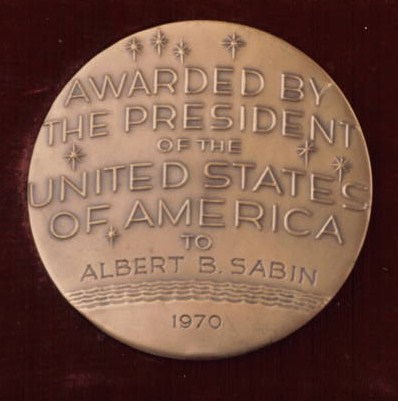 The National Science Foundation (NSF) is celebrating the 50th anniversary of the National Medal of Science with a new online exhibit. In 1959, President Dwight D. Eisenhower signed legislation creating the National Medal of Science. President John F. Kennedy awarded the first medal to Theodore von Kármán in 1963. This new exhibit features some of the 476 men and women who have been recognized for “their outstanding contributions to knowledge in the physical, biological, mathematical, or engineering sciences,”[1] including our own Dr. Albert Bruce Sabin.
The National Science Foundation (NSF) is celebrating the 50th anniversary of the National Medal of Science with a new online exhibit. In 1959, President Dwight D. Eisenhower signed legislation creating the National Medal of Science. President John F. Kennedy awarded the first medal to Theodore von Kármán in 1963. This new exhibit features some of the 476 men and women who have been recognized for “their outstanding contributions to knowledge in the physical, biological, mathematical, or engineering sciences,”[1] including our own Dr. Albert Bruce Sabin.
 Albert Sabin was awarded a National Medal of Science in 1970 by President Richard Nixon. He received this National Medal of Science for “numerous fundamental contributions to the understanding of viruses and viral diseases, culminating in the development of the vaccine which has eliminated poliomyelitis as a major threat to human health.” Check out Sabin’s biography and other award recipients at the NSF’s National Medal of Science 50th Anniversary online exhibit!
Albert Sabin was awarded a National Medal of Science in 1970 by President Richard Nixon. He received this National Medal of Science for “numerous fundamental contributions to the understanding of viruses and viral diseases, culminating in the development of the vaccine which has eliminated poliomyelitis as a major threat to human health.” Check out Sabin’s biography and other award recipients at the NSF’s National Medal of Science 50th Anniversary online exhibit!
(Images of the front and back of Dr. Sabin’s award are seen here in this blog post and will be in the newly digitized collection soon!)
Reference
[1] National Science Foundation. The National Medal of Science 50th Anniversary. Accessed 25 February 2013. http://www.nsf.gov/news/special_reports/medalofscience50/index.jsp
In 2010, the University of Cincinnati Libraries received a $314,258 grant from the National Endowment for the Humanities (NEH) to digitize the correspondence and photographs of Dr. Albert B. Sabin. This digitization project has been designated a NEH “We the People” project, an initiative to encourage and strengthen the teaching, study, and understanding of American history and culture through the support of projects that explore significant events and themes in our nation’s history and culture and that advance knowledge of the principles that define America. Any views, findings, conclusions, or recommendations expressed in this blog do not necessarily reflect those of the National Endowment for the Humanities.
